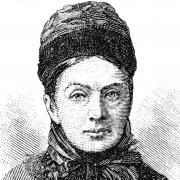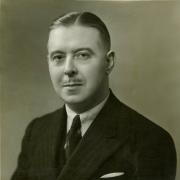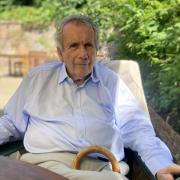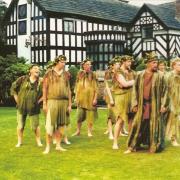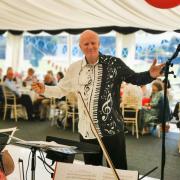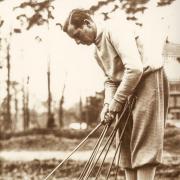One hundred years ago George Herbert Leigh-Mallory and Andrew ‘Sandy’ Irvine died together on the North Face of Mount Everest. Stephen Roberts tells the story of their heroic attempt to conquer the mighty peak and ponders whether the fellow Cheshire men achieved their mission before they perished
A Cheshire-born mountaineer and explorer, charismatic idealist, romantic and teacher, George Herbert Leigh-Mallory, or George Mallory as he was better known, was a Boys’ Own adventurer who participated in the first three Everest expeditions in the early to mid-1920s. He was the only climber to feature in all three. There remains an intriguing possibility that his 1924 party may have been the first to conquer the peak; it’s likely to remain forever unproven, his disappearance on the mountain, becoming one of the 20th century’s enduring mysteries.

History records that the Earth’s tallest mountain, Everest, was first scaled in May 1953 by Edmund Hillary and Tenzing Norgay, the news breaking as the Coronation of HM Queen Elizabeth II dawned. Relatively few will know of the courageous bid to defeat the mountain nearly three decades earlier when Mallory and Andrew ‘Sandy’ Irvine headed heaven-bound a century ago this month. They were last spotted about 800 vertical feet from the summit and would never be seen alive again. These two gallant climbers were both men of Cheshire. Mallory’s body was to be found on the mountain he tried to tame 75 years after he’d disappeared.
Mallory was born in Mobberley on 18th June 1886, the son of a clergyman, Herbert Leigh Mallory, who was the latest in a long line of such clerics, and Annie Jebb. He was one of four siblings; his brother Trafford Leigh-Mallory was the most senior RAF officer killed during WW2.
Mallory displayed his passion for climbing from an early age – he tackled the roof of St Wilfrid's, in Mobberley, where his father was rector, when he was just seven. Mallory’s birthplace was Newton Hall in Mobberley, the family moving to Hobcroft House in the village at the end of 1891. Having attended his first prep school in West Kirby (until 1896), Mallory left the family home for a scholarship to Winchester College in September 1900. It was here his love of climbing would be encouraged thanks to a master who took a small party climbing in the Alps every year. Mallory followed this by becoming a student of history at Magdalene College, Cambridge; then teaching at Charterhouse School in Godalming, while developing his climbing skills with trips to Wales and the Alps. Other climbers of the time would note his natural, cat-like ability to find routes upward. He became a member of Britain’s prestigious Alpine Club so would be in the forefront of minds when the club later began planning the first significant Everest expedition.

Mallory’s climbing partner, ‘Sandy’ Irvine, was also a Cheshire man, born in Birkenhead on 8th April 1902, one of six siblings, with a mother descended from a longstanding county family and a father with mixed Scottish and Welsh antecedents. Irvine, a student at Birkenhead School, developed a passionate interest in engineering, permitting him to fix or develop mechanical ‘stuff’; being a sportsman and Oxford rowing blue’ brought him to the attention of the 1920s Everest expeditions.
Mallory, meanwhile, married Ruth Turner (1892-1942) in 1914, a union that bestowed a son and two daughters on the couple. Mallory would serve in WW1 as a lieutenant in the British Army (1915-18), fighting on the Somme, before resuming teaching duties at Charterhouse once the war was over, in 1919. He tendered his resignation when the first of the Everest expeditions came calling.

The 1920s saw a trio of expeditions to Everest (the 1921 reconnaissance, the 1922 ascent when supplemental (bottled) oxygen was used for the first time and seven Sherpa porters lost their lives in an avalanche, and the disastrous 1924 expedition). It was a time when trying to climb Everest was every bit as audacious as landing a man on the moon 45 years later and was to be attempted by a group dressed in home knitting and tweed. Whereas the experienced Mallory was an ever-present on these undertakings, the younger Irvine was a rookie on the final expedition, making this his only attempt to conquer the mountain. Mallory had exchanged teaching children for teaching adults in Cambridge in 1923, something he found particularly rewarding; sadly it was to be a short-lived endeavour. The sad irony was that Mallory felt settled and wasn’t sure he wanted to tackle Everest again. Mallory and Irvine departed these shores for the last time in February 1924, setting sail from Liverpool, bound for the Himalayas, along with two others. The climbing party, once assembled, would consist of 10 men, one of whom was a translator. In the same month, Mallory and a dozen others were honoured with Winter Olympic gold medals in recognition of the achievements of the 1922 expedition, when a world altitude record was achieved.
Two attempts had already been made to attain the mighty mountain’s summit before Mallory decided, perhaps surprisingly, that the inexperienced Irvine would join him on the final try that the weather and season would permit. It had already been a troubled bid with high winds and deep snows to contend with. Irvine the ‘fixer’ had already proved a whizz with the team’s oxygen apparatus, however, and this is quite possibly what swayed Mallory in the final analysis. What occurred on that fatal attempt remains mysterious to this day. Beginning their ascent on 6th June, by the conclusion of the following day they had established camp at 26,800 feet, from which they could launch the final push. The last sighting of the two men was at 12:50 p.m. on the 8th ‘going strongly for the top’. They never returned.

In May 1999, George Mallory’s frozen body was discovered just beneath the height of the pair’s last camp, the remnants of a rope still around his waist, suggesting the two climbers had been joined together at the end. Frustratingly, it remains a mystery whether the courageous mountaineers had achieved the summit in a fleeting moment of unheralded glory, dying due to an accident during their perilous descent, or indeed whether calamity, rather more prosaically, and less romantically, overtook them on the ascent. Mallory remains on the mountain that became his lifelong obsession, his body buried where it had been discovered. He was not quite 38 when he perished. Irvine’s body has never been found; the young man was just 22 when he disappeared. Mallory’s camera, which could conceivably solve the mystery, has yet to be found.
Mallory, as with many 1920s mountaineers, was already a hero, having seen action in the Great War; Irvine was a representative of a younger generation, yet nevertheless imbued with the heart of a lion and a determination to push himself to the fullest reach of his endurance. The best and most appropriate commemoration to the two men is, perhaps the one adorning a window of the Chester Cathedral cloister as it recalls: ‘Two valiant men of Cheshire… who adventured their lives even unto death’. The pair became inseparable in life and shared the same fate; they should be remembered together. As well as being commemorated in the cathedral, Mallory is remembered in window panels in St Wilfrid’s, Mobberley, the church he climbed as a lad. The George Mallory Foundation was established in 2020 to establish a memorial to Mobberley’s most famous son in his home village.
The last word should perhaps be left to Mallory, who conjured an immortal and oft-repeated phrase in America on a 1923 lecture tour. He’d been asked for the umpteenth time why it was that he wanted to climb the mountain. He retorted: ‘Because it’s there’.
CHRONOLOGY
1886 – Birth of George Herbert Leigh-Mallory in Mobberley (18th June)
1891 – The Mallory family moves to Hobcroft House in Mobberley (until 1904)
1914 – Marries Ruth Turner, a union that bestowed three children
1915 – Serves in WW1 as a lieutenant, seeing action on the Somme
1921 – The first of Mallory’s three expeditions to Everest is primarily a reconnaissance
1922 – The second Everest expedition achieves a world altitude record
1924 – Death of George Mallory on Everest’s North Face in June aged 37
1953 – Everest is definitively conquered by Hillary and Norgay
1999 – Discovery of Mallory’s body on the mountain he tried to defeat






